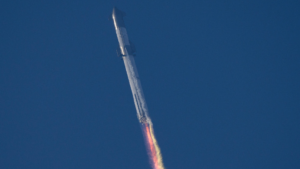
Why SpaceX’s Falcon Heavy Went 3 Years Without a Launch
After a few successful launches in 2019, the Falcon Heavy would go on to sit dormant for over 3 years without a single mission. The rocket had demonstrated itself as one of the most powerful and cost-effective launch vehicles in the industry, yet nobody was using it.
In reality, the answer to why it was grounded for so long comes down to a partial lack of demand, the success of the Falcon 9, and various delays. All of which contributed to the over three-year-long hiatus from any launches. This eventually changed in recent years, but is worth noting when looking at the rocket’s future. Here I will go more in-depth into the 3-year hiatus, why this happened, what the future of this vehicle looks like, and more.
No Launches

On February 6th, 2018, Falcon Heavy lifted off for the first time and stunned the world with its immense power and successful dual side booster landing. This mission alone proved that a new type of rocket was available within the industry and ready to be utilized. About a year later, the rocket launched again for Arabsat carrying a heavy communications satellite. Finally, in June 2019, Falcon Heavy lifted off one more time with a military satellite on top for the United States Department of Defense. Between June 2019 and November 2022, there was not a single Falcon Heavy mission. The rocket had seemingly disappeared after a very impressive start.
One of the main reasons for this was the success of the Falcon 9. After developing the Falcon 9 SpaceX worked to improve and increase the launch vehicle’s performance. On the other hand, when developing Falcon Heavy, the company was not exactly sure what the Falcon 9 would be capable of. SpaceX was so successful that the Falcon 9 became a lot more powerful than expected. So powerful that a number of planned missions for Falcon Heavy ended up getting moved to the Falcon 9. In this case, different commercial companies needing a ride to low Earth orbit for example simply did not require the immense payload capacity that the Falcon Heavy offered. Instead, they opted for a less expensive ride on the Falcon 9. SpaceX sells Falcon 9 missions for close to $67 million, whereas a standard Heavy flight goes for around $97 million.
Another reason had to do with a lack of demand. The area where Falcon Heavy really shines is heavy satellites meant for distant orbits. This specific mission profile narrows down the options significantly and mostly includes military launches. Between 2019 and 2022, the need for such a powerful rocket was simply limited. Delays also caused this stretch of no launches to continue. Several planned Falcon Heavy launches were pushed back due to issues with their satellites. USSF-44 for example was originally supposed to lift off in late 2020, but payload problems scuttled that plan. This launch finally took place on the rocket’s long awaited return, back in November 2022. In addition, there were a few competitors that offered comparable capabilities including Arianespace’s Ariane 5 and United Launch Alliance’s Delta IV Heavy, which both launched within that time period.
Lastly, around the time of Falcon Heavy development and lack of launches, SpaceX was ramping up work on Starship. It seems as if the company had a lot of plans but was unsure exactly what each project would be capable of and when. This packed full schedule and various options likely contributed to the lack of launches for various other reasons as well. Even though all this information sounds somewhat grim for the rocket, in the grand scheme of things they have had a lot of success with Falcon Heavy and made a notable amount of money. For example, a year after the successful demo flight, SpaceX had signed five commercial contracts worth US$500–750 million, meaning that it had managed to cover the development cost of the rocket. SpaceX was also awarded 40% of the launches in Phase 2 of the National Security Space Launch (NSSL) contracts, which includes several launches and a vertical integration facility and development of a larger fairing, from 2024-2027. Now in early 2024, the rocket is coming out of its busiest year ever.
Demand Increases

After Falcon Heavy finally did return, it began launching more than we had ever seen before. In 2023, it launched a total of 5 times averaging a mission every few months. The first was USSF-67 in mid-January. Here they used a new center core in an expendable configuration (no grid fins or landing gear), while the two reused side-boosters landed at Cape Canaveral Space Force Station. The second stage had a gray band for thermal purposes as the mission requirements were similar to the USSF-44 mission.
Next in May, they moved on to the Viasat 3 launch. In the beginning, Falcon Heavy was set to launch the Viasat-2 satellite, but due to delays, an Ariane 5 launch vehicle was used instead. Viasat maintained the launch option and delivered its next Ka-band satellite aboard the Falcon Heavy – this one intended to provide service to the Americas region. The upper stage went on to successfully deploy the additional payloads, G-Space 1 and Arcturus. Similar to the previous launch, it featured a thermal gray band second stage.
The next three included Jupiter-3, Psyche, and the most recent being Boeing’s X-37B spaceplane. All were successful and saw the payloads deployed as intended. Now at the start of 2024, SpaceX has another busy year planned for Falcon Heavy.
In only a few months from now in April, the next launch is scheduled. In September 2021, NASA awarded SpaceX launch services contract for the geostationary GOES-U weather satellite. Only a few days ago the agency reported that the Geostationary Operational Environmental Satellite U (GOES-U), the fourth and final weather-observing and environmental monitoring satellite in NOAA’s GOES-R Series, is now in Florida. The satellite landed on Tuesday, Jan. 23, in a United States Air Force C-5M Super Galaxy cargo plane at the Launch and Landing Facility at NASA’s Kennedy Space Center.
They were quoted saying, “After testing and fueling are complete, the encapsulated spacecraft will move to the SpaceX hangar at Launch Complex 39A at NASA Kennedy. GOES-U is scheduled to launch no earlier than Tuesday, April 30, aboard a SpaceX Falcon Heavy rocket.”
Once this mission is complete, the next will happen not long after and is arguably even more exciting. Back in 2021, they announced, “The Europa Clipper mission will launch in October 2024 on a Falcon Heavy rocket from Launch Complex 39A at NASA’s Kennedy Space Center in Florida. The total contract award amount for launch services is approximately $178 million. Specifically, Europa Clipper will conduct a detailed survey of Europa and use a sophisticated suite of science instruments to investigate whether the icy moon has conditions suitable for life. Key mission objectives are to produce high-resolution images of Europa’s surface, determine its composition, look for signs of recent or ongoing geological activity, measure the thickness of the moon’s icy shell, search for subsurface lakes, and determine the depth and salinity of Europa’s ocean. The mission will make flybys of Mars and Earth before arriving at Jupiter in April 2030.
Once this mission is complete, there is one more scheduled for 2024 using this rocket. In November, they plan to launch a lunar lander and spacecraft to the Moon’s South Pole. Interestingly, the mission is a joint one between SpaceX, NASA, and Astrobotic. In this case, Astorbotic is providing the lunar lander that will deliver NASA’s spacecraft. Just recently during United Launch Alliance’s first Vulcan launch, the Astrobotic lander experienced a propulsion anomaly that ruined its chances at landing on the Moon. Over a week ago the lander reentered the atmosphere over the South Pacific, ending the mission. While far from ideal, they are hoping to have a very different outcome on the next mission.
Looking even further into the future, there are some very important missions using the Falcon Heavy. For example, while delays are possible, in 2025 it will launch both the PPE and HALO Gateway modules. The Power and Propulsion Element and Habitation and Logistics Outpost are foundational elements of the Gateway. NASA says, “As the first long-term orbiting outpost around the Moon, the Gateway is critical to supporting sustainable astronauts missions under the agency’s Artemis program.
In another quote they say, “After integration on Earth, the PPE and HALO are targeted to launch together no earlier than May 2024 on a Falcon Heavy rocket from Launch Complex 39A at NASA’s Kennedy Space Center in Florida. The total cost to NASA is approximately $331.8 million, including the launch service and other mission-related costs” they said. The launch date has changed since then but the plan is still the same. The original plan was to launch them separately but they decided to just send them together on one vehicle that could do the job. This led to the selection of Falcon Heavy and preparation for the mission. Besides the future launches that I’ve listed, there are another 10-plus missions scheduled for Falcon Heavy between now and 2029. Something to look forward to in the coming years.
Conclusion
SpaceX’s Falcon Heavy had an impressive start but then didn’t launch for over 3 years. This mainly came down to a lack of demand, the capability of the Falcon 9, and Starship development. We will have to wait and see how it progresses and the impact it has on the space industry.



